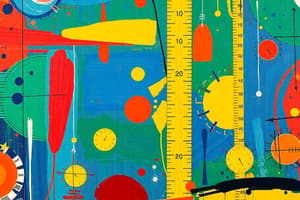Podcast
Questions and Answers
What is a fundamental quantity?
What is a fundamental quantity?
- A quantity that can be derived from other measurements
- A physical quantity dependent on another quantity
- A basic measure of physical magnitudes that stands alone (correct)
- Any measurable value that uses arbitrary units
Which of the following is NOT classified as a fundamental quantity?
Which of the following is NOT classified as a fundamental quantity?
- Weight (correct)
- Temperature
- Electric current
- Length
What unit is used to measure mass in the SI system?
What unit is used to measure mass in the SI system?
- Kilogram (correct)
- Gram
- Milligram
- Pound
Which pair correctly matches a fundamental quantity with its unit?
Which pair correctly matches a fundamental quantity with its unit?
In physical measurements, the term 'unit' refers to:
In physical measurements, the term 'unit' refers to:
What phenomenon causes the apparent change in position of an object observed from two different viewpoints?
What phenomenon causes the apparent change in position of an object observed from two different viewpoints?
Which of the following is not a correct representation of a unit symbol?
Which of the following is not a correct representation of a unit symbol?
Why is the parallax method essential for measuring large distances?
Why is the parallax method essential for measuring large distances?
Which unit prefix represents the factor of $10^{-9}$?
Which unit prefix represents the factor of $10^{-9}$?
How should the unit of acceleration be correctly represented?
How should the unit of acceleration be correctly represented?
Flashcards are hidden until you start studying
Study Notes
Units and Measurements
- Physics relies on quantitative measurement of various physical quantities, such as mass, length, and temperature.
- Measurements require a comparison with internationally accepted standard units, e.g., 5 m indicates 5 meters.
- Different quantities are represented by specific units: length (meter), time (seconds), mass (kilograms).
System of Units
- Fundamental quantities that do not depend on other quantities include length, mass, time, temperature, electric current, luminous intensity, and amount of substance.
- Seven fundamental quantities are defined with corresponding SI units:
- Length: meter (m)
- Mass: kilogram (kg)
- Time: second (s)
- Temperature: Kelvin (K)
- Electric current: ampere (A)
- Luminous intensity: candela (cd)
- Amount of substance: mole (mol)
Measurement of Length
- Standard unit for length is the meter; defined based on light's travel distance in vacuum (1983).
- Large distances to celestial objects are measured using the parallax method, based on the apparent positional change due to the observer's perspective.
- Common distances in meters:
- Andromeda Galaxy: 2 × 10²² m
- Proxima Centauri: 4 × 10¹⁶ m
- Pluto: 6 × 10¹² m
- Earth’s radius: 6 × 10⁶ m
Distances in Astronomy
- Astronomers utilize units such as:
- 1 Astronomical Unit (AU): 1.496 × 10¹¹ m
- 1 Light Year: 9.467 × 10¹⁵ m
- 1 Parsec (pc): 3.08 × 10¹⁶ m
- Angular diameter formula helps calculate the size of celestial bodies using their distance and observed angle.
Dimensional Analysis
- Dimensions express derived physical quantities in terms of fundamental quantities (length, mass, time).
- Equations must have same dimensions on both sides to be dimensionally correct (principle of homogeneity).
- Examples of physical quantities include:
- Density: kg/m³
- Acceleration: m/s²
- Force: N (newton)
Accuracy, Precision, and Uncertainty in Measurement
- Accuracy denotes how close measurements are to the true value; precision indicates reproducibility of measurements.
- Uncertainties in measurements can arise from instrument quality, experimenter skill, measurement methods, and external factors.
Errors in Measurements
- Errors categorized into systematic and random:
- Systematic errors arise from calibration issues or individual biases; examples include instrumental and personal errors.
- Random errors stem from unpredictable influences and can be minimized by repeated observations.
Measurement of Mass and Time
- Kilogram defined by electric current as of May 20, 2019, replacing the earlier physical standard.
- SI unit of time is the second (s), previously defined in relation to a solar day.
Uses of Dimensional Analysis
- Checking the correctness of equations (homogeneity).
- Establishing relationships between related physical quantities.
- Finding conversion factors between different measurement systems.
Estimation of Error
- Absolute error is the deviation of measured values from the mean; mean absolute error assesses overall measurement accuracy.
- Relative error quantifies the error in relation to the mean value.
Errors in Operations
- When adding or subtracting quantities, maximum absolute error is the sum of individual errors.
- For products, relative error involves the sum of individual relative errors, excluding negligible products of small errors.
Studying That Suits You
Use AI to generate personalized quizzes and flashcards to suit your learning preferences.




